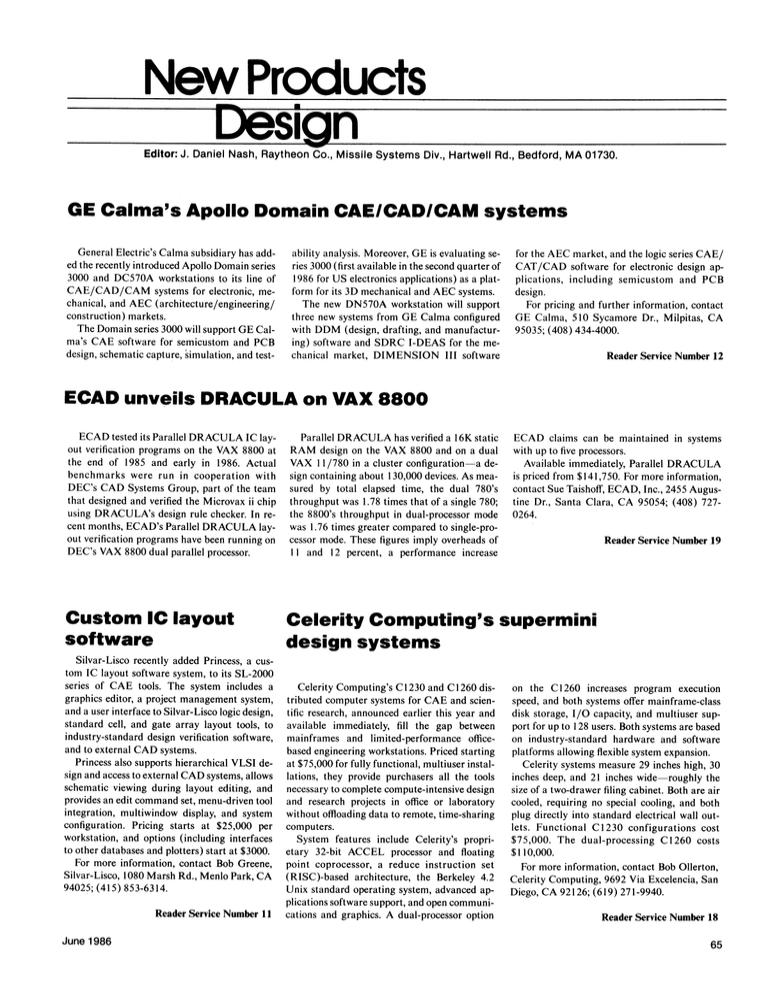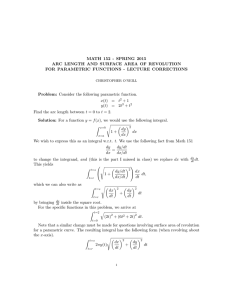New Products Design
advertisement

NewDesigns Products Editor: J. Daniel Nash, Raytheon Co., Missile Systems Div., Hartwell Rd., Bedford, MA 01730. GE Calma's Apollo Domain CAE/CAD/CAM systems General Electric's Calma subsidiary has added the recently introduced Apollo Domain series 3000 and DC570A workstations to its line of CAE/CAD/CAM systems for electronic, mechanical, and AEC (architecture/engineering/ construction) markets. The Domain series 3000 will support GE Calma's CAE software for semicustom and PCB design, schematic capture, simulation, and test- ability analysis. Moreover, GE is evaluating series 3000 (first available in the second quarter of 1986 for US electronics applications) as a plat- for the AEC market, and the logic series CAE/ CAT/CAD software for electronic design applications, including semicustom and PCB form for its 3D mechanical and AEC systems. design. The new DN570A workstation will support For pricing and further information, contact three new systems from GE Calma configured GE Calma, 510 Sycamore Dr., Milpitas, CA with DDM (design, drafting, and manufacturing) software and SDRC I-DEAS for the mechanical market, DIMENSION III software 95035; (408) 434-4000. Reader Service Number 12 ECAD unveils DRACULA on VAX 8800 ECAD tested its Parallel DRACULA IC layout verification programs on the VAX 8800 at the end of 1985 and early in 1986. Actual benchmarks were run in cooperation with DEC's CAD Systems Group, part of the team that designed and verified the Microvax ii chip using DRACULA's design rule checker. In recent months, ECAD's Parallel DRACULA layout verification programs have been running on DEC's VAX 8800 dual parallel processor. Parallel DRACULA has verified a 16K static RAM design on the VAX 8800 and on a dual VAX 11/780 in a cluster configuration-a design containing about 130,000 devices. As measured by total elapsed time, the dual 780's throughput was 1.78 times that of a single 780; the 8800's throughput in dual-processor mode was 1.76 times greater compared to single-processor mode. These figures imply overheads of 11 and 12 percent, a performance increase Custom IC layout software Celerity Computing's supermini design systems Silvar-Lisco recently added Princess, Reader Service Number 19 a cus- tom IC layout software system, to its SL-2000 series of CAE tools. The system includes a graphics editor, a project management system, and a user interface to Silvar-Lisco logic design, standard cell, and gate array layout tools, to industry-standard design verification software, and to external CAD systems. Princess also supports hierarchical VLSI design and access to external CAD systems, allows schematic viewing during layout editing, and provides an edit command set, menu-driven tool integration, multiwindow display, and system configuration. Pricing starts at $25,000 per workstation, and options (including interfaces to other databases and plotters) start at $3000. For more information, contact Bob Greene, Silvar-Lisco, 1080 Marsh Rd., Menlo Park, CA 94025; (415) 853-6314. Reader Service Number 11 June 1986 ECAD claims can be maintained in systems with up to five processors. Available immediately, Parallel DRACULA is priced from $141,750. For more information, contact Sue Taishoff, ECAD, Inc., 2455 Augustine Dr., Santa Clara, CA 95054; (408) 7270264. Celerity Computing's C1230 and C1 260 distributed computer systems for CAE and scientific research, announced earlier this year and available immediately, fill the gap between mainframes and limited-performance officebased engineering workstations. Priced starting at $75,000 for fully functional, multiuser installations, they provide purchasers all the tools necessary to complete compute-intensive design and research projects in office or laboratory without offloading data to remote, time-sharing computers. System features include Celerity's proprietary 32-bit ACCEL processor and floating point coprocessor, a reduce instruction set (RISC)-based architecture, the Berkeley 4.2 Unix standard operating system, advanced applications software support, and open communications and graphics. A dual-processor option on the C 1260 increases program execution speed, and both systems offer mainframe-class disk storage, I/O capacity, and multiuser support for up to 128 users. Both systems are based on industry-standard hardware and software platforms allowing flexible system expansion. Celerity systems measure 29 inches high, 30 inches deep, and 21 inches wide-roughly the size of a two-drawer filing cabinet. Both are air cooled, requiring no special cooling, and both plug directly into standard electrical wall outlets. Functional C1230 configurations cost $75,000. The dual-processing C1260 costs $110,000. For more information, contact Bob Ollerton, Celerity Computing, 9692 Via Excelencia, San Diego, CA 92126; (619) 271-9940. Reader Service Number 18 65 DASH-PCB -Data I/O's new PCB router Displayed at the recent NEPCON and ADEE shows, Data I/O FutureNet Division's DASH-PCB fits on the engineer's desk along with other DASH tools for schematic entry and simulation. DASH-PCB uses up to five different routing algorithms to assure maximum finished-board density, and users can alter algorithm execution sequences. Once a target circuit has been designed and simulated on a FutureNet DASH workstation, its net list is extracted and used as input for DASH-PCB. Parts placement is interactive and trace routing is automatic, although users have the option to work interactively. Additional software facilities support six postprocessing tasks including back annotation, automatic parts-insertion files, a bill of materials, a parts list, NC drill files, and fabrication and assembly drawings. Standard features include gate and pin swapping, step-and-repeat macros for building buses, and upload/download ability letting DASH-PCN interface with VAX or IBM mainframes. Priced from $13,000 depending on configuration, DASH-PCB deliveries (four weeks ARO) began in March. For more information, contact FutureNet Corporation, 9310 Topanga Canyon Blvd, Chatsworth, CA 91311; (818) 700-0691. Reader Service Number 20 PC workbench software for analog design Analog Design Tools, Inc. recently announced the first CAE software providing a complete set of analog circuit design tools on a PC. This PC-based version of ADT's Analog Workbench (that runs on Sun, Apollo, and HP workstations) offers most of the original product features at half the cost. Like the original, the PC Workbench lets designers construct circuits, attach simulated test instruments, and see test results on a screen without using conventional workbench tools. Software functions include a circuit editor, three test setups (time domain, frequency domain, and DC multimeter), spectral analysis, parameter entry, parametric plotting, subcircuits, and statistical analysis. The PC Workbench runs SPICE PLUS, ADT's version of the new SPICE 3 software, and includes ADT's device model library. PC Workbench is available as a $12,500 PC upgrade kit including the Opus 32032 board, mouse, documentation, and seven software modules: the circuit editor, SPICE PLUS, DC multimeter, time- and frequency-domain test setups, the spectrum analyzer, and parameter entry with subcircuit capability. Options include the parametric plotting module, the statistical analysis module, a basic 50-member device library, ADT's 500-member general device library, and range in price from $2500 to $12,000. For more information, contact Michael Carroll, Analog Design Tools, Inc., 66 Willow Pi., Menlo Park, CA 94025; (415) 328-0780. Reader Service Number 15 AIDA's high-speed CAE workstation AIDA Corporation's recently introduced CAE workstation, first available in April, was targeted at systems designers doing complex digital design. It features testability and analysis tools, simulation capability, and a knowledge-based rules checker. The initial platform for AIDA's design system is the Apollo 32-bit workstation. AIDA's tools include a logic design rules checker, automatic test pattern generator, system simulator accelerator, schematic design editor, symbol editor, cell libraries, timing libraries, librarian, and automatic logic documenter. A typical configuration-Apollo workstation, schematic capture, logic and fault simulation, and the cosimulator accelerator-costs $140,000. Current Apollo users can upgrade to an AIDA design system for $85,000. For more information, contact Georgia Marszalek, AIDA Corporation, 3375 Scott Blvd., Ste. 340, Santa Clara, CA 95054; (408) 748-8571. Reader Service Number 13 66 The AIDA design system for complex digital design. IEEE DESIGN & TEST IMS adds dc parametric testing to Logic Master The new parametric measurement unit from Integrated Measurement Systems allows design engineers to verify and measure prototypical IC dc parametric characteristics in the design envi- Integrated parametric testing in IMS Logic Master's design verification system gives designers the ability to perform functional verification as well as full device characterization of ronment. state-of-the-art ICs such as ECL and CMOS gate arrays, standard cells, and full custom devices. Including a complete switching matrix verification station for device fixturing, the PMU matrix allows users to disconnect drivers and receivers from the DUT and route the dc PMU to the desired IC pin for measurement, all under automated program control. Parametric measurement ability is further enhanced through a software automeasure feature that automatically develops a parametric test sequence covering every DUT pin. The PMU comes in two versions: The PMU- 1001 (at $19,200) provides a PMU and switching matrix to support up to 192 channels, while the PMU-2001 (at $31,200) supports up to 384 channels. Both systems permit users either to force voltage and measure current, or to force current and measure voltage on any IC-undertest pin. Available 16 weeks from receipt of or- der, standard Logic Master configurations with PMU begin at $48,700. For more information, contact Integrated Measurement Systems, Inc., 9525 SW Gemini Dr., Beaverton, OR 97005; (503) 626-7117. The new parametric measurement unit from IMS. Reader Service Number 17 ADEPT -SDL's integrated mixed-mode simulator Silicon Design Labs' L-Simulator combines a behavioral timing simulator, a switch level simulator, and ADEPT-a new circuit simulator. According to SDL, ADEPT improves performance two to three times over that of SPICE with less than a five percent error factor: Since matrices are not required during simulation, CPU requirements only increase linearly with the number of nodes, rather than by the square of the number of nodes as SPICE does. The L-Simulator is positioned in an interactive environment allowing users to simulate and edit circuits simultaneously, while viewing resulting states and waveforms on a graphics display. The entire design process can be tracked with a single simulation tool, from initial behavioral specification to performance verification. The interactive environment enables users to verify operation and performance of CMOS, NMOS, or bipolar circuits. For pricing and further information, contact David R. Reiser, Silicon Design Labs, Inc., 645 Martinsville Rd., PO Box 16, Liberty Corner, NJ 07853; (201) 580-0102. Reader Service Number 14 Mentor Graphics design kit for CMOS 3 Mentor Graphics Corporation recently introduced its design kit for CMOS 3, a three-micrometer CMOS standard cell library distributed by the USC/ISI MOSIS project. The kit was jointly developed by Mentor Graphics, the Aerospace Corporation, and BMAC (Boeing) with MOSIS project cooperation. The kit is currently in beta test at several sites. Mentor Graphics and BMAC have al- June 1986 ready completed VLSI circuitry using the new kit. BMAC engineers designed an IC to incorporate over 1200 CMOS 3 macros (about 4000 gates) and completed the concept-to-manufacturing data cycle in four weeks. Within eight weeks, BMAC engineers had functioning prototypes. Kits are available from Mentor Graphics for $400. For more information, contact Brian Kiernan, Mentor Graphics Corporation, 8500 SW Creekside P1., Portland, OR 97005; (503) 626-1301. Reader Service Number 16 67


